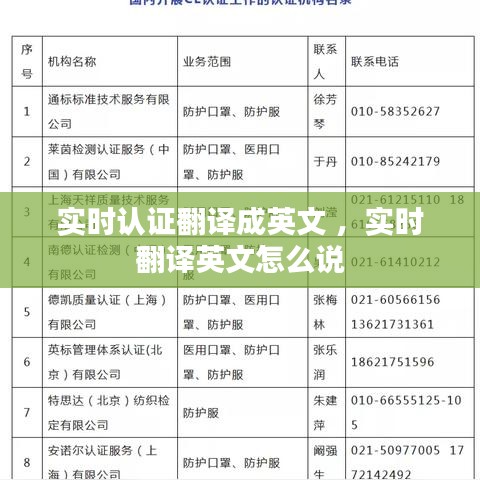Introduction to Real-Time Authentication
In today's digital age, the need for secure and efficient authentication methods has become more crucial than ever. Real-time authentication is a cutting-edge technology that has revolutionized the way we verify identities and protect sensitive information. This article delves into the concept of real-time authentication, its importance, and how it can be translated into English for global audiences.
What is Real-Time Authentication?
Real-time authentication refers to the process of verifying a user's identity instantly, as they attempt to access a system, application, or service. This method ensures that the user is who they claim to be at the moment of access, reducing the risk of unauthorized access and data breaches. Real-time authentication combines various techniques, including biometrics, one-time passwords (OTP), and behavioral analytics, to provide a robust security layer.
The Importance of Real-Time Authentication
With the increasing number of cyber threats and data breaches, organizations are under immense pressure to secure their digital assets. Real-time authentication plays a pivotal role in this endeavor by offering several key benefits:
Enhanced Security: By providing immediate verification, real-time authentication significantly reduces the risk of identity theft and unauthorized access.
Improved User Experience: Users no longer have to wait for verification processes, leading to a smoother and more efficient login experience.
Compliance with Regulations: Many industries are subject to strict data protection regulations that require robust authentication methods. Real-time authentication helps organizations meet these compliance requirements.
Cost-Effective: Although implementing real-time authentication may involve initial investment, it can lead to long-term cost savings by reducing the incidence of security breaches and related damages.
Translating Real-Time Authentication into English
When translating the term "real-time authentication" into English, it is important to consider the context in which it is being used. Here are a few ways to express this concept in English:
Real-Time Identity Verification
Instant Authentication Process
Immediate Identity Validation
On-the-Spot Authentication
These translations capture the essence of the term and can be used in various contexts, such as technical documentation, marketing materials, or presentations.
Challenges in Real-Time Authentication
While real-time authentication offers numerous advantages, it also comes with its own set of challenges:
Technical Complexity: Implementing real-time authentication requires advanced technology and expertise, which can be a barrier for some organizations.
Privacy Concerns: Real-time authentication often involves the collection and analysis of personal data, raising privacy concerns that need to be addressed.
False Positives/Negatives: Biometric systems, for instance, may occasionally misidentify users, leading to false positives or negatives.
Scalability: As organizations grow, ensuring that real-time authentication systems can handle increased loads without compromising performance can be challenging.
Conclusion
Real-time authentication is a vital component of modern security strategies, providing instant verification and protecting against cyber threats. By understanding the concept and its various translations, organizations can effectively communicate the benefits of real-time authentication to a global audience. While challenges exist, the continuous advancement of technology is likely to address these issues, making real-time authentication an even more integral part of secure digital interactions.
转载请注明来自中维珠宝玉石鉴定,本文标题:《实时认证翻译成英文 ,实时翻译英文怎么说》













 豫ICP备17041525号-2
豫ICP备17041525号-2